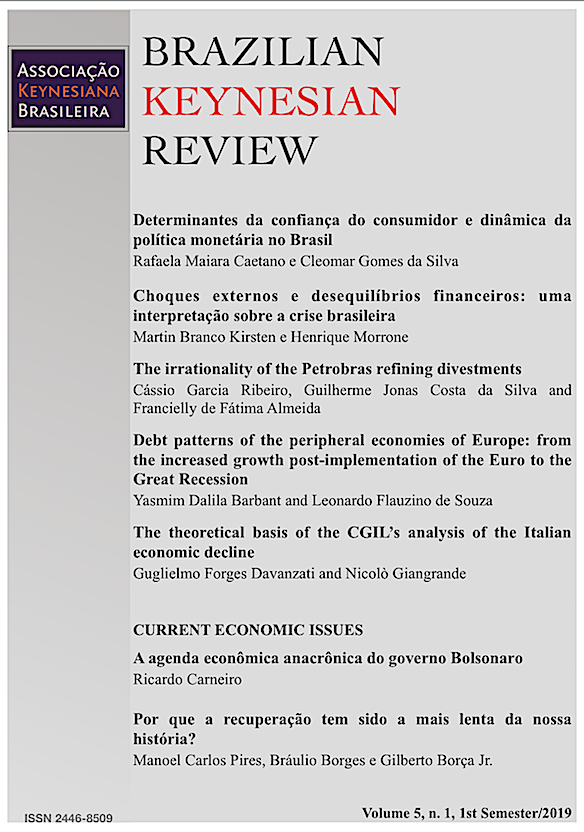Choques externos e desequilíbrios financeiros: uma interpretação sobre a crise brasileira
Resumo
O presente trabalho investiga as causas da recessão brasileira iniciada em 2014. Se por um lado o diagnóstico convencional atribui a crise a um descontrole das finanças públicas, outras interpretações enfatizam choques externos e um excessivo endividamento do setor privado. A hipótese alternativa é que a deterioração das contas públicas é uma consequência da crise e não a sua causa. Utiliza-se a metodologia desenvolvida por Toda e Yamamoto (1995), a fim de verificar a hipótese de não causalidade de Granger entre as séries temporais dos resultados do setor privado, setor público e saldo em conta corrente do Banco Central do Brasil (BCB, 2017) para o período de novembro de 2002 a junho de 2017. Os resultados sugerem que os saldos dos setores externo e privado causam no sentido de Granger o saldo (resultado) do setor público.Downloads
Referências
Abell, J. D. (1990). Twin deficits during the 1980s: An empirical investigation. Journal of macroeconomics, 12(1), 81–96.
Almeida, M., Lisboa, M. B., & Pessoa, S. (2015). O ajuste inevitável. Folha de São Paulo. Disponível em: <http://www1.folha.uol.com.br/fsp/
ilustrissima/226576-ajuste-inevitavel.shtml
Arestis, P., de Paula, L. F., & Ferrari, F. (2007). Assessing the economic policies of President Lula da Silva in Brazil: has fear defeated hope? In: P. Arestis & M. Sawyer (Eds.) Political economy of Latin America: recent economic performance. Basingstoke: Palgrave Macmillan.
BCB - Banco Central Do Brasil. (2017). Séries temporais. Disponível em: <http://www4.bcb.gov.br/pec/series/port/aviso.asp>. Acesso em 10 de outubro de 2017
Barro, R. J. (1974). Are government bonds net wealth? Journal of political economy, 82(6), 1095-1117.
Bolle, M. B. (2016). Como matar a borboleta-azul: Uma crônica da era Dilma. Rio de Janeiro: Intrínseca.
Borges, B. (2016). Bad Luck or Bad Policy: uma investigação das causas do baixo crescimento da economia brasileira nos últimos anos. In: R. Bonelli & F. Veloso (Orgs.), A Crise de Crescimento no Brasil. Elsevier/FGV-Ibre.
Bresser-Pereira, L. C. (2017). Como sair do regime liberal de política econômica e da quase-estagnação desde 1990. Estudos Avançados, 31(89), 7-22. doi: 10.1590/s0103-40142017.31890002
Carvalho, L.B. (2018). Valsa brasileira: do boom ao caos econômico. São Paulo: Todavia.
Christ, C. F. (1968). A simple macroeconomic model with a government budget restraint. The Journal of Political Economy, 76(1), 53-67.
Cripps, F., & Godley, W. (1976). A formal analysis of the Cambridge economic policy group model. Economica, New Series, 43(172), 335-348. doi: 10.2307/2553270
Godley, W. (1999a). Seven unsustainable processes. New York: Levy Economic Institute of Bard College, Annandale-on-Hudson.
Keynes, J. M. (1936 [1985]). A Teoria Geral do Emprego, do Juro e da Moeda. São Paulo: Nova Cultural.
Marquetti, A., Koshiyama, D., & Alencastro, D. (2009). O aumento da lucratividade expande a acumulação de capital? Uma análise de causalidade de Granger para países da OCDE. Revista de Economia Contemporânea, 13(3), 367-390. doi: 10.1590/S1415-98482009000300001
Nassif, A. (2018). A valsa não totalmente afinada de Laura Carvalho: um ensaio-resenha crítico de Valsa brasileira: do boom ao caos econômico. Cadernos do Desenvolvimento, 13(23), 11-35.
Nikiforos, M., Carvalho, L., & Schoder, C. (2015). “Twin deficits” in Greece: in search of causality. Journal of Post Keynesian Economics, 38(2), 302-330. doi: 10.1080/01603477.2015.1065675
Ocampo, A. C., Rada, C., & Taylor, L. (2009). Growth and policy in developing countries: A structuralist approach. Columbia University Press.
Ocampo, J. (2009). Patterns of Net Borrowing in Open Developing Economies. In J. A. Ocampo, C. Rada, & L. Taylor (Orgs.), Growth and policy in developing countries: a structuralist approach (pp. 75-83). New York: Columbia University Press.
Oreiro, J. L. (2017). A grande recessão brasileira: diagnóstico e uma agenda de política econômica. Estudos Avançados, 31(89), 75-88. doi: 10.1590/s0103-40142017.31890009
Pessoa, S. (2016). Crise fiscal estrutural deve resultar em alta inflação no médio prazo. Revista Conjuntura Econômica, 70(10), 10-11.
Polak, J. J. (1957). Monetary analysis of income formation and payments problems. International Monetary Fund Staff Papers, 6(1), 1–50. doi: 10.2307/3866128
Prebisch, R. (1949). O desenvolvimento econômico da América Latina e seus principais problemas. Revista Brasileira de Economia, 3(3), 47-111.
Rezende, F. (2016). Financial fragility, instability and the Brazilian crisis: a Keynes-Minsky-Godley approach. Minds (Multidisciplinary Institute for Development and Strategies): Discussion paper, 1.
Rezende, F. (2017). Desalavancagem do setor privado. Valor Econômico. Disponível em: <http://www.valor.com.br/opiniao/5038378/
desalavancagem-do-setor-privado>
Toda, H., & Yamamoto, T. (1995). Statistical inference in vector autoregressions with possibly integrated processes. Journal of Econometrics, 66(1-2), 225-250. doi: 10.1016/0304-4076(94)01616-8
Volcker, P.A. (1984). Facing up to the twin deficits. Challenge, 27(1), 4–9. doi: 10.1080/05775132.1984.11470902
Copyright (c) 2019 Martin Branco Kirsten, Henrique Morrone

This work is licensed under a Creative Commons Attribution 4.0 International License.
- Autores mantém os direitos autorais e concedem à revista o direito de primeira publicação, com o trabalho simultaneamente licenciado sob a Licença Creative Commons Attribution que permite o compartilhamento do trabalho com reconhecimento da autoria e publicação inicial nesta revista.
- Autores têm autorização para assumir contratos adicionais separadamente, para distribuição não-exclusiva da versão do trabalho publicada nesta revista (ex.: publicar em repositório institucional ou como capítulo de livro), com reconhecimento de autoria e publicação inicial nesta revista.
- Autores têm permissão e são estimulados a publicar e distribuir seu trabalho online (ex.: em repositórios institucionais ou na sua página pessoal) a qualquer ponto antes ou durante o processo editorial, já que isso pode gerar alterações produtivas, bem como aumentar o impacto e a citação do trabalho publicado (Veja O Efeito do Acesso Livre).


